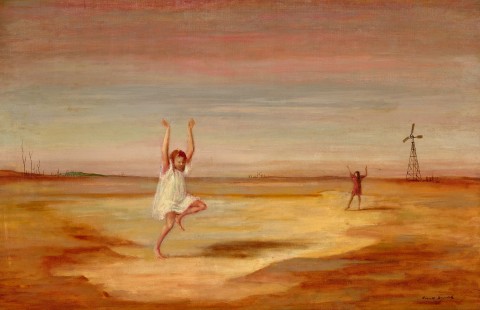CHILDREN DANCING, 1950
RUSSELL DRYSDALE
oil on canvas
66.0 x 102.0 cm
signed lower right: Russell Drysdale
inscribed with title verso: ’CHILDREN DANCING’ / RUSSELL DRYSDALE / c/o MACQUARIE GALLERIES, / 19 BLIGH ST / SYDNEY
Macquarie Galleries, Sydney (partial label attached verso)
Mervyn Horton, Sydney
The Estate of Mervyn Horton, Sydney
Joseph Brown Gallery, Melbourne
Private collection, Melbourne, acquired from the above in November 1983
Russell Drysdale, The Macquarie Galleries, Sydney, 9 – 21 August 1950, cat. 10
Russell Drysdale, The Leicester Galleries, London, 30 November – 23 December 1950, cat. 16
First Loan Exhibition: Contemporary Australian paintings selected from private collections in Sydney, Art Gallery Society of New South Wales, Sydney, 28 September – 19 October 1955, cat. 21 (as ‘Dancing Children’)
Contemporary Australian Paintings: Pacific Loan Exhibition, on board Orient Line S.S. Orcades, Sydney, 2 October 1956; Auckland, 8 October 1956; Honolulu, 16 October 1956; Vancouver, 22 October 1956; San Francisco, 25 October 1956; National Art Gallery, Sydney, November 1956, cat. 22 (label attached verso, as ‘Dancing Children’)
Famous Paintings from Australian Homes, David Jones Art Gallery, Sydney, 14 – 24 May 1957, cat. 36 (as ‘The Children’)
Contemporary Australian Art, Auckland City Art Gallery, Auckland, May 1960, cat. 18 (label attached verso)
Russell Drysdale Retrospective 1937 – 1960, Art Gallery of New South Wales, Sydney, 5 October – 6 November 1960, cat. 66 (label attached verso, as ‘Children Dancing, No. 2’)
On long term loan to the Bendigo Art Gallery, Victoria, 2005 – 2023
Gleeson, J., ‘Drysdale reveals the ‘gold of art’’, The Sun, Sydney, 9 August 1950, p. 30
McKie, R., ‘Drysdale takes Australia to London’, The Daily Telegraph, Sydney, 12 October 1950, p. 8 (as ‘Dancing Children’)
‘Sundry Shows: Russell Drysdale’, The Bulletin, Sydney, vol. 71, no. 3679, 16 August 1950, p. 23
‘Drysdale Paintings’, The Bulletin, Sydney, vol. 72, no. 3729, 1 August 1951, p. 2 (as ‘The Dancing Children’)
Hamilton, G., Summer Glare, Angus and Robertson, London, 1960, illus. front cover
Haefliger, P., Russell Drysdale Retrospective 1937 – 1960, Ure Smith, Sydney, 1960, cat. 66, p. 58 (as ‘Children Dancing, No. 2’)
‘Sundry Shows: Russell Drysdale’, The Bulletin, Sydney, 12 October 1960, vol. 81, no. 4209, p. 23 (as ‘Children Dancing in the Desert’)
Dutton, G., Russell Drysdale, Thames and Hudson, London, 1964, pl. 66 (illus., as ‘Children Dancing, No. 2’), p. 188
Dutton, G., Russell Drysdale, Thames and Hudson, London, 1969, pl. 65, pp. 88, 91 (illus., as ‘Children Dancing, No. 2’), 204
Pringle, J., Russell Drysdale’s Australia, Sydney Ure Smith, Sydney, 1974, p. 1 (illus., as ‘Children Dancing, No. 2’)
Thomas, D., ’The Mervyn Horton collection’, Art and Australia, Fine Arts Press, Sydney, Spring 1983, pp. 78 (illus., as ‘Children Dancing, No. 2’), 79
230016 Broken Mountain cmyk FA.jpg
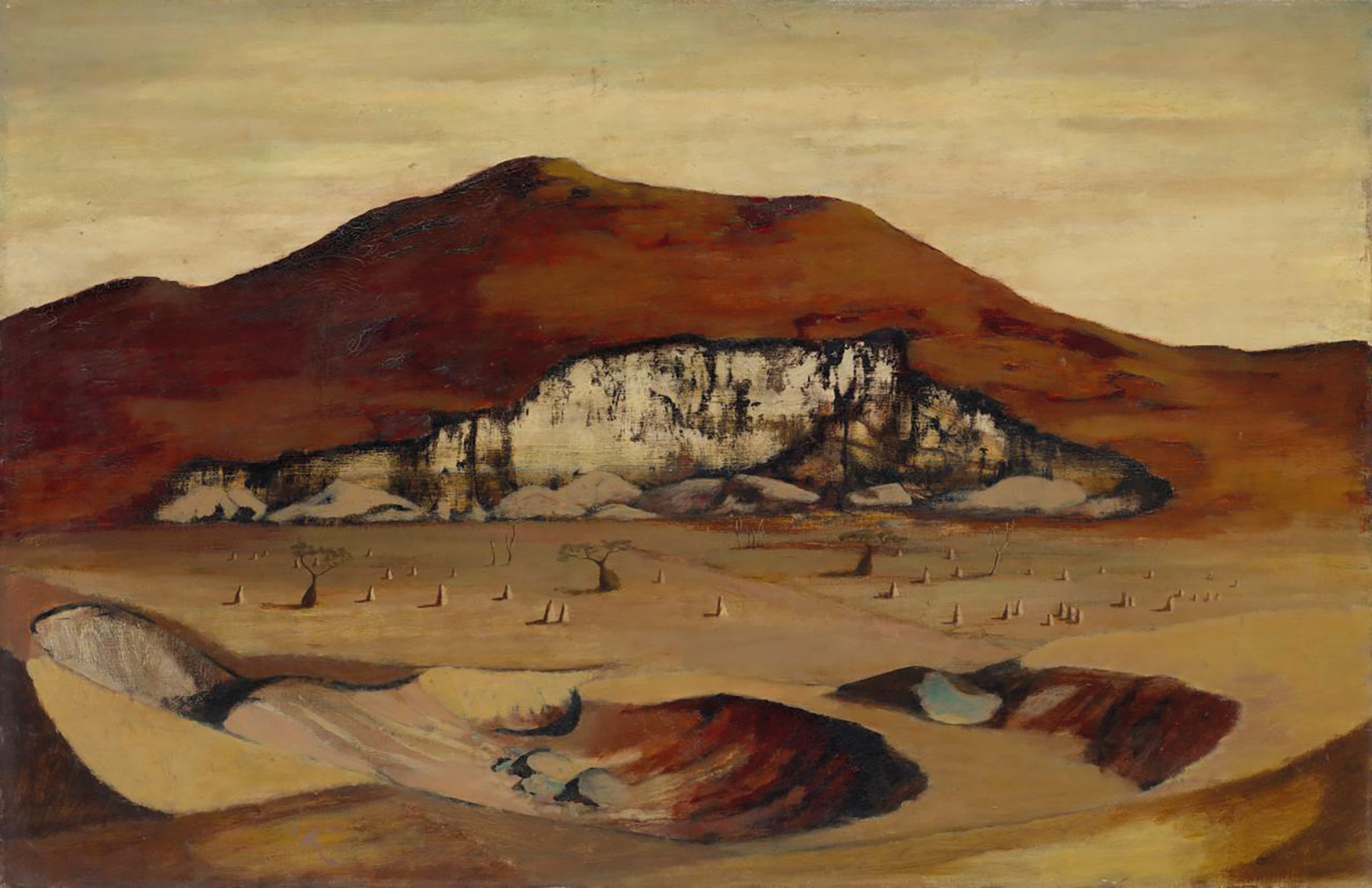
Russell Drysdale’s paintings of Australia and its inhabitants helped define our national identity, capturing the essence of the country and the character of its people. When his now iconic depictions of rural Australia first appeared in the early 1940s however, there was no artistic precedent for the imagery of a harsh and unyielding landscape populated by stoic, resilient people. Representing a decisive break from the romantic pastoral imagery of the late nineteenth and early twentieth centuries, Drysdale’s vision focussed on the experience of outback and country life, infusing elements of Surrealism and Expressionism into his realistic approach, and making a profound contribution to the visual representation of Australian life. One of the best-known artists of his generation, Drysdale’s art is on permanent display in major galleries throughout the country and he remains a household name.
His path to a career as an artist was more coincidence than the result of focussed planning. Recovering from eye surgery in 1932, he passed the time by drawing. Impressed by what he saw, Drysdale’s doctor, Julian Smith – ‘that strange and brilliant mixture of surgeon, artist and photographer’1 – showed his work to Daryl Lindsay. A successful painter, member of the famed artistic family, and later director of the National Gallery of Victoria, Lindsay recalled that Drysdale’s work ‘showed a curious sensitivity and a sharp observation.’2 Born into a family with extensive farming interests – including Boxwood Park in the Riverina district – the young Drysdale ‘liked Lindsay because he had had the same sort of life that I had led… He had been a jackeroo [sic.] and a station manager and we could talk about horses and sheep.’3 Although Drysdale had always imagined a life on the land, this attention from respected artworld figures prompted him to consider a creative career and a subsequent introduction to George Bell, the influential modern artist and teacher, sealed his fate.
Drysdale-Suppliment-Image-.jpg
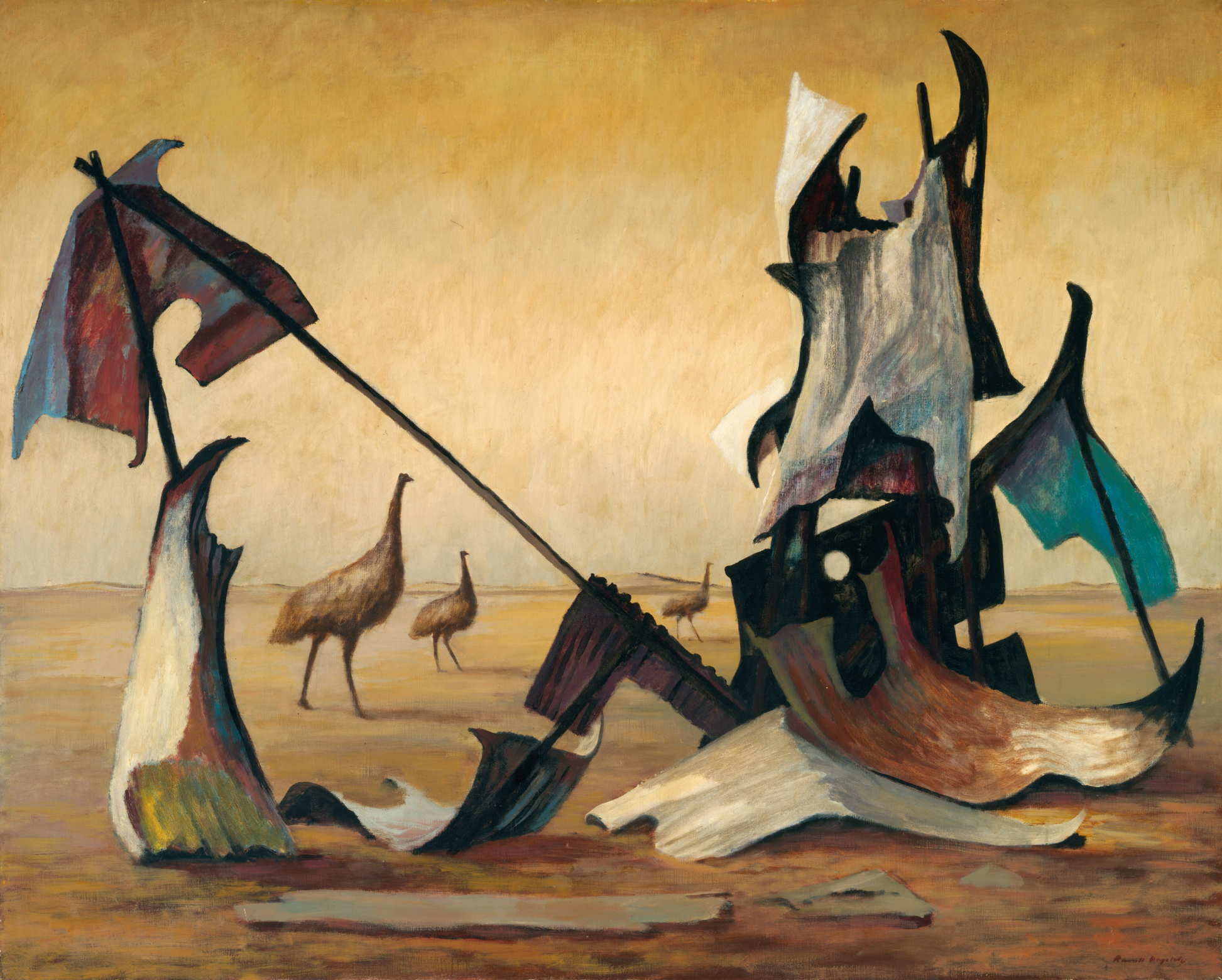
Drysdale enrolled at the Shore–Bell School in Melbourne in 1935 after extended travel in England and Europe. Having seen the work of the Impressionists and modern artists there for the first time, he was fuelled with the desire to paint, later saying, ‘I… got to like these things tremendously and I wanted to do it… quite suddenly they had a meaning which they never had in books.’4 He absorbed Bell’s teaching, which emphasised the importance of imagination and encouraged individual expression, as well as developing a sound technical knowledge of the materials and processes of his craft. Bell also instilled in his students the importance of drawing, believing that its practice ‘is as essential to an artist as practising scales to a pianist.’5 Drysdale’s first solo exhibition at Riddell Galleries, Melbourne in 1938 included The Rabbiter and his Family, 1938 (National Gallery of Australia) and Monday Morning, 1938 – purchased by his friend Maie Casey, who sold it a few years later to the Metropolitan Museum of Art, New York – and the critical response was overwhelmingly positive. Writing in the Melbourne Herald, Basil Burdett proclaimed, ‘I have seldom seen a more promising exhibition by a young painter anywhere.’6
During a trip to Australia in 1949, renowned British art historian Kenneth Clark visited Drysdale’s studio and bought The Councillor’s House, 1948 – 49 – a painting based on the artist’s recent trip to Hill End – for his personal collection. Early the following year Clark wrote to Drysdale advising that Leicester Galleries in London wanted to present a major solo exhibition of recent paintings. While a June 1950 date was suggested, he did not have enough work ready to show, and the exhibition was scheduled for December that year. Inspired by the prospect of an exhibition at such a respected London gallery – where artists including Matisse and Picasso had also had their first London solo shows – Drysdale worked at a solid pace, but he was also excited by recent travels through Queensland which had presented him with a wide range of new subject-matter. Fourteen of the paintings exhibited in London were finished by August – including Emus in a landscape, 1950 (National Gallery of Australia) and Broken Mountain, 1950 (National Gallery of Victoria) – when they were shown at Macquarie Galleries in Sydney prior to being packed and shipped.7 Children Dancing, 1950 was among this group of paintings and it was the subject of considerable positive commentary from the local critics. The Daily Telegraph writer described it eloquently as ‘a rare, beautiful, and tragic canvas, in which two children dance against an empty landscape, not to music, but to the silence of their red and rainless outback world.’8 James Gleeson regarded the greatest works among the ‘rich and exciting’ presentation as those which depicted figures in the landscape, and highlighted Children Dancing among this group. Summing up the exhibition, he wrote:
231016.jpg
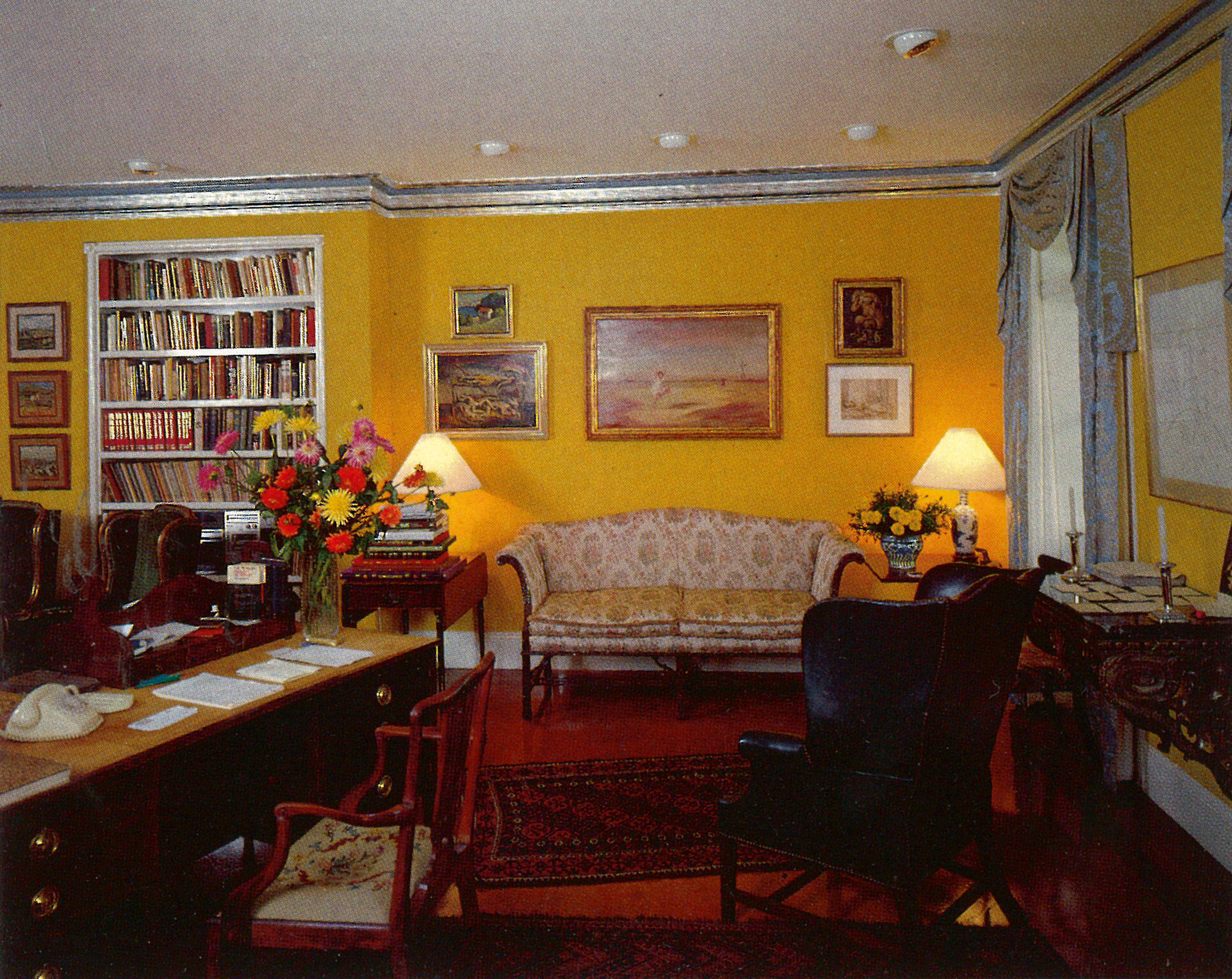
Potts Point, Sydney, 1983
Art and Australia, Fine Arts Press, Sydney, Spring 1983, p. 78
‘These pictures have the impact of a profound emotional experience, yet every element in them is controlled by a clear and watchful intelligence that rigorously suppresses any hint of emotionalism. No other artist, with the possible exception of Sidney Nolan, has succeeded in capturing so much of the essence of inland Australia, yet these landscapes have been constructed with quite as much respect for the verities of classical art as one would find in a Poussin.’9
Children Dancing follows a closely related, smaller work which was painted the previous year.10 The earlier image depicts two young girls dancing barefoot, with arms raised, in a flat and featureless desert landscape. Space is condensed in this picture, the figures are close to the picture plane, and the viewer feels part of an intimate scene. In contrast, the pictorial space in the current work is vast, with low-lying hills just visible on the distant horizon. Tall, spindly trees on the left, painted with the utmost delicacy, are balanced by a windmill on the far right, and the strong verticality of these elements – such ubiquitous features of the Australian outback – in turn echoes the figures of the dancing children. Drysdale describes the dry, dusty earth with a palette of ochre, dark red and brown. The sky is immense and luminous, palest blue and green above the horizon and along the top of the painting, is a band of orange and pink which speaks to the heat of the day, as well as signalling that there is more to come. While the landscape of this painting is tough and spare, it is the joyous free-spirited dancing of the figures that prevails.
Although London audiences were unfamiliar with the physical reality of Drysdale’s subject-matter and sometimes challenged by the ruggedness of the landscape he described, his paintings struck a chord. Reviewing the exhibition in a broadcast on the BBC Pacific Service, Eric Newton said, ‘There’s nothing lush or exuberant about Mr Drysdale’s Australia. I don’t feel an irresistible urge to emigrate to Australia – his Australia – as a result of visiting the show. But that has nothing to do with Mr Drysdale’s excellence as an artist. There are plenty of good pictures that take me to places I don’t particularly want to visit in real life’.11 He continued, ‘ he is a first-rate painter. His pictures are authentic accounts of a distant and unfamiliar continent. They are creations in their own right, and as such they have an authority, a unity, a presence of their own.’12
230016 cmyk FA.jpg
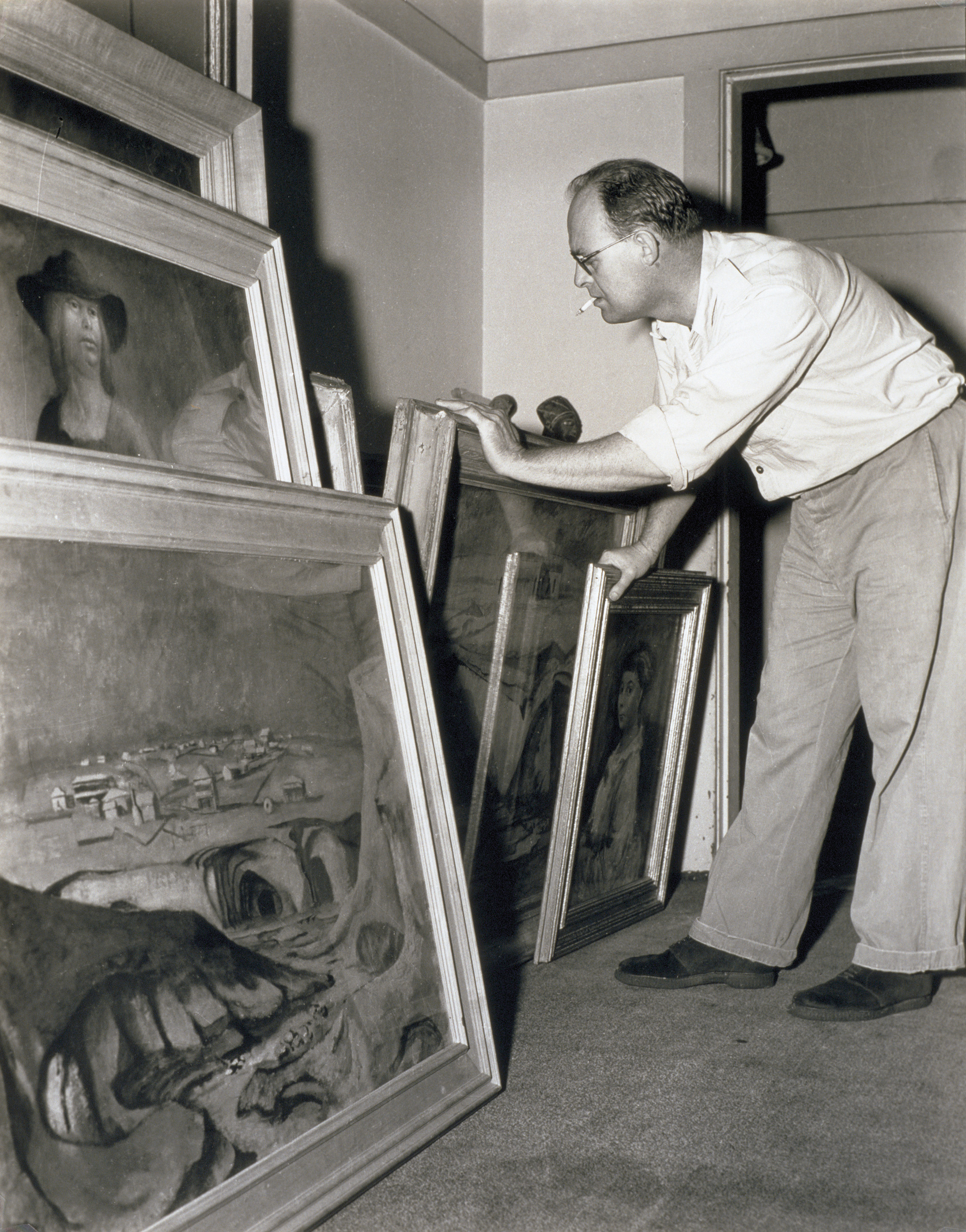
Timothy Fairfax AC 2003
Alongside the positive reviews came good sales. Nine paintings were sold on the opening day, including one to Sir Laurence Olivier, who had previously met Drysdale and his wife in Sydney. War Memorial, 1950 was selected for the Tate Gallery, and while the artist was reportedly disappointed by this choice, representation in such an important international collection added significantly to his developing reputation. Drysdale was one of a small handful of twentieth century Australian artists to achieve this level of recognition during his lifetime. In addition to being represented in the Tate and New York’s Metropolitan Museum of Art, his work was also included in major private collections including that of Her Majesty Queen Elizabeth II. Acknowledgement of his great talent also came in 1954, when he was selected alongside Sidney Nolan and William Dobell to represent Australia at the XXVII Venice Biennale – the first time Australia had participated in this pre-eminent international exhibition of contemporary art – and in 1969, when his contribution to Australian art was recognised with a knighthood.
Having been owned by Mervyn Horton, Children Dancing has a distinguished provenance. Employed as an editor by Sam Ure Smith in 1951, he was also secretary to the Society of Artists, as well as being gallery manager for their annual exhibition, and in this way was very familiar with the Sydney art world. In addition to editing several books on contemporary Australian art during the 1960s-early 80s, Horton is probably best known as editor of Art and Australia, which was launched in May 1963.13
1. Klepac, L., Russell Drysdale, Murdoch Books, Millers Point, 2009, p. 15
2. Ibid.
3. Drysdale interviewed by Geoffrey Dutton, quoted in Eagle, M. and Minchin, J., The George Bell School: Students, Friends, Influences, Deutscher Art Publications, Melbourne and Resolution Press, Sydney, 1981, p. 91
4. Klepac, op. cit., p. 21
5. Drysdale quoted in J.F. Nagle, ‘Preface’, Russell Drysdale, Richmond Hill Press, Melbourne, 1979
6. Burdett, B., ‘Young painter shows brilliant promise’, Herald, Melbourne, 26 April 1938, p. 10, quoted in Smith, G., Russell Drysdale 1912 – 81, National Gallery of Victoria, Melbourne, 1997, p. 19
7. The Leicester Galleries exhibition also included a number of earlier works loaned from collectors including Kenneth Clark: see Klepac, op. cit, p. 217
8. McKie, R., ‘Drysdale takes Australia to London’, The Daily Telegraph, Sydney, 12 October 1950, p.8
9. Gleeson, J., ‘Drysdale reveals the ‘gold of art’’, The Sun, Sydney, 9 August 1950, p. 30
10. Dancing Children No. 1, 1949, oil on canvas, 30.5 x 40.6 cm, illustrated in Klepac, op. cit., p. 206
11. Quoted in Klepac, ibid., pp. 220 – 221
12. Ibid.
13. Daniel Thomas, ‘Horton, Mervyn Emrys Rosser (1917 – 1983)’, Australian Dictionary of Biography, National Centre of Biography, Australian National University, https://adb.anu.edu.au/biography/horton-mervyn-emrys-rosser-12657/text22809, published first in hardcopy 2007, accessed online 6 March 2023
KIRSTY GRANT
